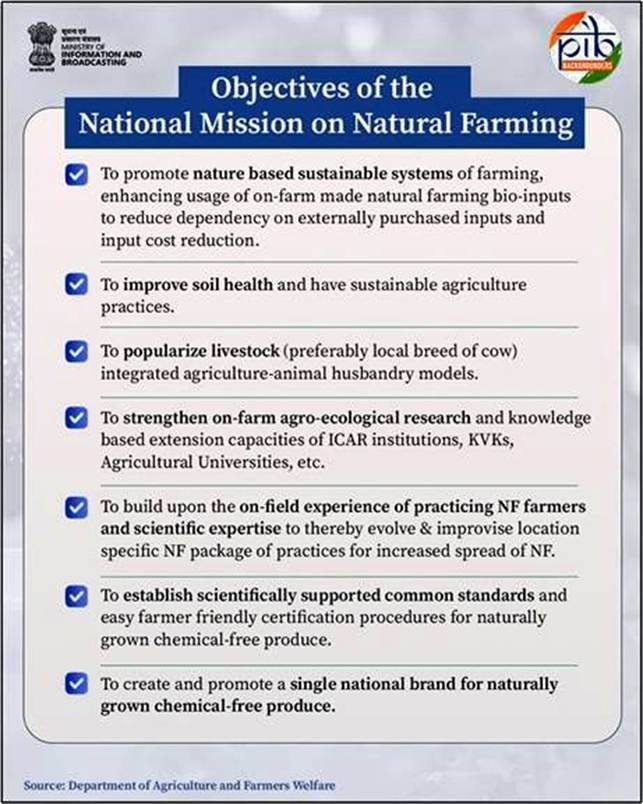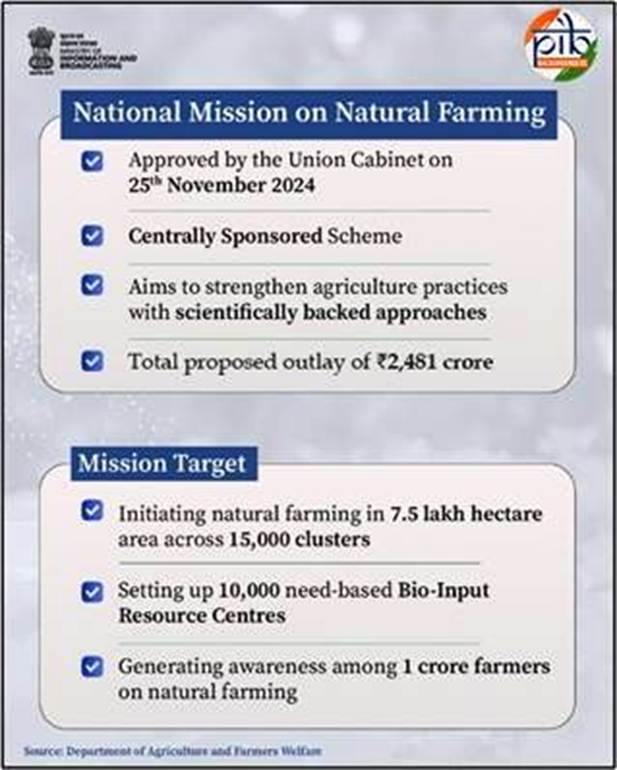Content
- National Mission on Natural Farming
- India Achieves Historic Milestone of 100 GW Solar PV Module Manufacturing Capacity under ALMM
National Mission on Natural Farming
Genesis and Evolution
- Approval & Launch:
- Approved by Union Cabinet on 25 November 2024.
- Operational till 15th Finance Commission cycle (2025–26).
- Launched as a standalone Centrally Sponsored Scheme (CSS).
- Predecessor Scheme:
- Restructured from Bharatiya Prakritik Krishi Paddhati (BPKP), which was under Paramparagat Krishi Vikas Yojana (PKVY, 2020–23).
- Budgetary Outlay:
- ₹2,481 crore total (Centre ₹1,584 crore; States ₹897 crore).
- Policy Shift:
- From input-intensive agriculture (Green Revolution model) → to low-input, ecosystem-based farming.
- Emphasis on traditional knowledge validated by science.
Relevance : GS 2(Governance) ,GS 3(Agriculture)

Objectives of NMNF
- Promote chemical-free agriculture and reduce farmer dependence on costly chemical fertilizers & pesticides.
- Enhance soil health and biodiversity, making farms climate-resilient.
- Strengthen farmer incomes through cost reduction and better market branding of NF produce.
- Establish 7.5 lakh hectares across 15,000 clusters of Natural Farming.
- Train and mobilize 1 crore farmers nationwide.
- Ensure last-mile delivery of inputs and guidance through Krishi Sakhis/Community Resource Persons (CRPs).
- Build bio-input infrastructure via 10,000 Bio-input Resource Centres (BRCs).
- Introduce Participatory Guarantee System (PGS)-based certification for NF produce.

Principles and Practices of Natural Farming
- Core Principle: Farming without synthetic chemicals, relying on livestock-based, bio-resource recycling systems.
- Key Components:
- Beejamrut (seed treatment formulation of cow dung, urine, soil, etc.).
- Jeevamrut (fermented microbial solution for soil fertility).
- Mulching & crop residue management to retain soil moisture.
- Diverse cropping systems for ecological balance.
- Ecosystem Approach: Integrates soil, water, plants, microbes, livestock, insects, and climate.
- Outcome Goals: Lower input costs, improved soil carbon, pest resistance through biodiversity, and resilience to climate shocks.
Implementation Architecture
- Cluster Model:
- 15,000 clusters, each of ~50 ha, ~125 farmers.
- New farmers can join at the start of each crop season.
- Incentives:
- ₹4,000/acre/year for 2 years (max 1 acre per farmer).
- Training & Handholding:
- 806 training institutions (KVKs, agri universities, NGOs).
- Model farms (1,100 developed) serve as learning hubs.
- 70,000+ Krishi Sakhis trained for community support.
- Monitoring:
- Online NMNF portal for geo-tagged, real-time monitoring.
- Multi-tier monitoring (Centre, State, District, Block).
Institutional Ecosystem
- NCONF (National Centre for Organic & Natural Farming, Ghaziabad):
- Standard setting, certification system.
- MANAGE (Hyderabad):
- Knowledge Partner for NF Extension.
- ICAR-KVKs:
- Research, demonstrations, curriculum development (UG/PG courses).
- Community Role:
- SHGs, FPOs, Panchayati Raj bodies actively engaged in awareness, input production, and marketing.
State-Level Initiatives (Precursor Models)
- Andhra Pradesh (APCNF): Large-scale community-managed NF with ecological balance focus.
- Gujarat (SPKK/PNF): Direct subsidies for cow upkeep and NF kits.
- Himachal Pradesh (PK3 Yojana): Achieved large farmer participation, >50,000 farmers by 2020.
- Rajasthan (Pilot Scheme): Training + input subsidies for NF adoption.
- Karnataka, Kerala, Uttar Pradesh: Also emerging as NF adopters with state support.
Progress till July 2025
- Farmers: 10 lakh+ enrolled.
- Clusters: Targets being operationalised across states.
- Training:
- 3,900 scientists/trainers trained.
- 28,000 CRPs mobilized.
- BRCs:
- 7,934 identified, 2,045 established.
- Funds Released:
- ₹177.78 crore (FY 2024–25) to states as per AAPs.
- Model Farms: 1,100 demonstration farms functional.
- Certification: PGS-India system being rolled out for NF produce.
Convergence and Integration
- Linked with multiple ministries for holistic outcomes:
- Agriculture & Farmers Welfare (input, training).
- Rural Development (MGNREGA convergence for farm labour).
- AYUSH (linkage of medicinal crops with NF).
- Food Processing (value addition, branding).
- Animal Husbandry (livestock integration).
- Market Linkages:
- Local haats, APMC mandis, FPO-driven value chains.
- Common national NF brand in progress.
- Educational Integration:
- RAWE (Rural Agricultural Work Experience) student participation.
- UG, PG & diploma courses on NF.
Challenges
- Adoption Barriers:
- Behavioural resistance among farmers used to chemical inputs.
- Yield concerns during initial transition period.
- Market Ecosystem:
- Certification and branding are still evolving.
- Limited consumer awareness compared to organic farming.
- Infrastructure Gaps:
- Only ~25% of targeted BRCs established by mid-2025.
- Monitoring & Extension:
- Requires strong local handholding; scale-up may strain resources.
- Policy Coordination:
- Need seamless convergence between central, state, and local agencies.
Strategic Significance
- Climate Change: NF promotes low-carbon farming, reduces chemical fertilizer dependence (aligned with India’s Net Zero 2070 goals).
- Economic: Cuts input costs, enhances small/marginal farmer viability.
- Health & Nutrition: Safer, chemical-free food for consumers.
- Global Positioning: Positions India as leader in regenerative & ecological farming, aligned with SDGs (2, 12, 13, 15).
Conclusion
- NMNF is not just a scheme but a paradigm shift—from “input-intensive productivity” to “nature-aligned sustainability.”
- Strong policy design, training ecosystem, and digital monitoring make it robust.
- The success depends on farmer behaviour change, market support, and scaling infrastructure.
- If effectively implemented, NMNF can be India’s flagship contribution to global sustainable agriculture models.
India Achieves Historic Milestone of 100 GW Solar PV Module Manufacturing Capacity under ALMM
Genesis and Evolution
- Approval & Launch:
- Approved by Union Cabinet on 25 November 2024.
- Operational till 15th Finance Commission cycle (2025–26).
- Launched as a standalone Centrally Sponsored Scheme (CSS).
- Predecessor Scheme:
- Restructured from Bharatiya Prakritik Krishi Paddhati (BPKP), which was under Paramparagat Krishi Vikas Yojana (PKVY, 2020–23).
- Budgetary Outlay:
- ₹2,481 crore total (Centre ₹1,584 crore; States ₹897 crore).
- Policy Shift:
- From input-intensive agriculture (Green Revolution model) → to low-input, ecosystem-based farming.
- Emphasis on traditional knowledge validated by science.
Relevance : GS 3(Energy Security )
Objectives of NMNF
- Promote chemical-free agriculture and reduce farmer dependence on costly chemical fertilizers & pesticides.
- Enhance soil health and biodiversity, making farms climate-resilient.
- Strengthen farmer incomes through cost reduction and better market branding of NF produce.
- Establish 7.5 lakh hectares across 15,000 clusters of Natural Farming.
- Train and mobilize 1 crore farmers nationwide.
- Ensure last-mile delivery of inputs and guidance through Krishi Sakhis/Community Resource Persons (CRPs).
- Build bio-input infrastructure via 10,000 Bio-input Resource Centres (BRCs).
- Introduce Participatory Guarantee System (PGS)-based certification for NF produce.
Principles and Practices of Natural Farming
- Core Principle: Farming without synthetic chemicals, relying on livestock-based, bio-resource recycling systems.
- Key Components:
- Beejamrut (seed treatment formulation of cow dung, urine, soil, etc.).
- Jeevamrut (fermented microbial solution for soil fertility).
- Mulching & crop residue management to retain soil moisture.
- Diverse cropping systems for ecological balance.
- Ecosystem Approach: Integrates soil, water, plants, microbes, livestock, insects, and climate.
- Outcome Goals: Lower input costs, improved soil carbon, pest resistance through biodiversity, and resilience to climate shocks.

Implementation Architecture
- Cluster Model:
- 15,000 clusters, each of ~50 ha, ~125 farmers.
- New farmers can join at the start of each crop season.
- Incentives:
- ₹4,000/acre/year for 2 years (max 1 acre per farmer).
- Training & Handholding:
- 806 training institutions (KVKs, agri universities, NGOs).
- Model farms (1,100 developed) serve as learning hubs.
- 70,000+ Krishi Sakhis trained for community support.
- Monitoring:
- Online NMNF portal for geo-tagged, real-time monitoring.
- Multi-tier monitoring (Centre, State, District, Block).
Institutional Ecosystem
- NCONF (National Centre for Organic & Natural Farming, Ghaziabad):
- Standard setting, certification system.
- MANAGE (Hyderabad):
- Knowledge Partner for NF Extension.
- ICAR-KVKs:
- Research, demonstrations, curriculum development (UG/PG courses).
- Community Role:
- SHGs, FPOs, Panchayati Raj bodies actively engaged in awareness, input production, and marketing.
State-Level Initiatives (Precursor Models)
- Andhra Pradesh (APCNF): Large-scale community-managed NF with ecological balance focus.
- Gujarat (SPKK/PNF): Direct subsidies for cow upkeep and NF kits.
- Himachal Pradesh (PK3 Yojana): Achieved large farmer participation, >50,000 farmers by 2020.
- Rajasthan (Pilot Scheme): Training + input subsidies for NF adoption.
- Karnataka, Kerala, Uttar Pradesh: Also emerging as NF adopters with state support.
Progress till July 2025
- Farmers: 10 lakh+ enrolled.
- Clusters: Targets being operationalised across states.
- Training:
- 3,900 scientists/trainers trained.
- 28,000 CRPs mobilized.
- BRCs:
- 7,934 identified, 2,045 established.
- Funds Released:
- ₹177.78 crore (FY 2024–25) to states as per AAPs.
- Model Farms: 1,100 demonstration farms functional.
- Certification: PGS-India system being rolled out for NF produce.
Convergence and Integration
- Linked with multiple ministries for holistic outcomes:
- Agriculture & Farmers Welfare (input, training).
- Rural Development (MGNREGA convergence for farm labour).
- AYUSH (linkage of medicinal crops with NF).
- Food Processing (value addition, branding).
- Animal Husbandry (livestock integration).
- Market Linkages:
- Local haats, APMC mandis, FPO-driven value chains.
- Common national NF brand in progress.
- Educational Integration:
- RAWE (Rural Agricultural Work Experience) student participation.
- UG, PG & diploma courses on NF.
Challenges
- Adoption Barriers:
- Behavioural resistance among farmers used to chemical inputs.
- Yield concerns during initial transition period.
- Market Ecosystem:
- Certification and branding are still evolving.
- Limited consumer awareness compared to organic farming.
- Infrastructure Gaps:
- Only ~25% of targeted BRCs established by mid-2025.
- Monitoring & Extension:
- Requires strong local handholding; scale-up may strain resources.
- Policy Coordination:
- Need seamless convergence between central, state, and local agencies.
Strategic Significance
- Climate Change: NF promotes low-carbon farming, reduces chemical fertilizer dependence (aligned with India’s Net Zero 2070 goals).
- Economic: Cuts input costs, enhances small/marginal farmer viability.
- Health & Nutrition: Safer, chemical-free food for consumers.
- Global Positioning: Positions India as leader in regenerative & ecological farming, aligned with SDGs (2, 12, 13, 15).
Conclusion
- NMNF is not just a scheme but a paradigm shift—from “input-intensive productivity” to “nature-aligned sustainability.”
- Strong policy design, training ecosystem, and digital monitoring make it robust.
- The success depends on farmer behaviour change, market support, and scaling infrastructure.
- If effectively implemented, NMNF can be India’s flagship contribution to global sustainable agriculture models.



